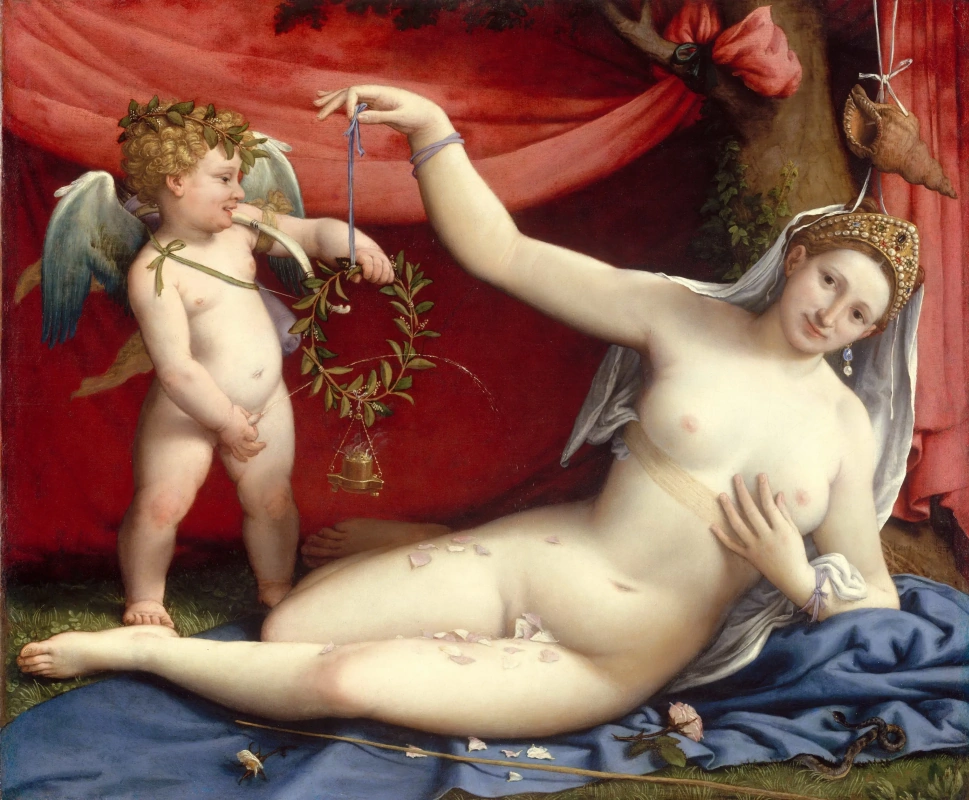log in
Enter site
Login to use Arthive functionality to the maximum
Vénus et Cupidon
Lorenzo Loto • Peinture, 1525, 92.4×111.4 cm












Descriptif de la toile «Vénus et Cupidon»
Lotto – l'un des plus intéressants, polyvalents et artistes originaux italien Cinquecento. Ne connaissons pas les circonstances de la commande de ce travail. Peut-être, la peinture a été écrit à la demande de son neveu de l'artiste Mario d'Армано. Typique, apparemment, pour le Loto scène est soumis à l'iconographie d'un point de vue assez complexe, donner la possibilité à de multiples interprétations. Le plus simple est celle qui interprète l'œuvre comme une allégorie de bonheur: le style d'idee de travail, vraisemblablement écrit à l'occasion du mariage, correspond directement à un classique эпиталамам.
Dans la composition domine la figure de Vénus (il n'est pas exclu de son portrait ressemblance avec la mariée), à la tête de laquelle est couronné d'une magnifique diadème avec des faveurs de mariage voile. Un lavabo, des pétales de rose, qui comme tout à l'penchée sur son sein, et le myrte sont les symboles classiques, идентифицирующими la déesse. D'autres détails de la composition sont associés avec l'amour et la fidélité: миртовая guirlande et un encensoir, rouge couvert de lierre. Cupidon fait pipi à travers les myrtes (la couronne, ce qui signifie les souhaits de la fertilité et de l'heureux destin de l'union.
Sur le premier plan représente un serpent, presque invisible parmi les plis de la draperie sur lesquels repose le Vénus. Certains ont tendance à l'associer avec un sentiment de jalousie. Mais selon les anciennes croyances, ce reptile était фаллическим un symbole lié à la terre Mère, et est ici l'allégorie du bonheur et de la fertilité.
Au second plan, derrière la tête de Vénus, l'accent est mis sur les pousses de lierre, обвившего arbre. Les caractéristiques principales de plantes grimpantes, c'est qu'elles sont persistantes et se développent, «embrassant» des troncs d'arbres. Le lierre s'est associé à des manifestations d'amour et d'amitié, devenant un symbole de la fidélité et de l'amour éternel.
L'artiste a réussi miraculeusement afficher audacieuse de l'expression et de la méchanceté de Cupidon. Sur la tête fidèle compagnon de Vénus - la couronne de myrte (sacré pour la déesse de la plante), почитавшегося dans l'antiquité comme un symbole de fertilité. Cette interprétation est pris en charge ici et le geste divin garçon, signifiant heureux et fécond de l'union.
Dans la composition domine la figure de Vénus (il n'est pas exclu de son portrait ressemblance avec la mariée), à la tête de laquelle est couronné d'une magnifique diadème avec des faveurs de mariage voile. Un lavabo, des pétales de rose, qui comme tout à l'penchée sur son sein, et le myrte sont les symboles classiques, идентифицирующими la déesse. D'autres détails de la composition sont associés avec l'amour et la fidélité: миртовая guirlande et un encensoir, rouge couvert de lierre. Cupidon fait pipi à travers les myrtes (la couronne, ce qui signifie les souhaits de la fertilité et de l'heureux destin de l'union.
Sur le premier plan représente un serpent, presque invisible parmi les plis de la draperie sur lesquels repose le Vénus. Certains ont tendance à l'associer avec un sentiment de jalousie. Mais selon les anciennes croyances, ce reptile était фаллическим un symbole lié à la terre Mère, et est ici l'allégorie du bonheur et de la fertilité.
Au second plan, derrière la tête de Vénus, l'accent est mis sur les pousses de lierre, обвившего arbre. Les caractéristiques principales de plantes grimpantes, c'est qu'elles sont persistantes et se développent, «embrassant» des troncs d'arbres. Le lierre s'est associé à des manifestations d'amour et d'amitié, devenant un symbole de la fidélité et de l'amour éternel.
L'artiste a réussi miraculeusement afficher audacieuse de l'expression et de la méchanceté de Cupidon. Sur la tête fidèle compagnon de Vénus - la couronne de myrte (sacré pour la déesse de la plante), почитавшегося dans l'antiquité comme un symbole de fertilité. Cette interprétation est pris en charge ici et le geste divin garçon, signifiant heureux et fécond de l'union.
Œuvres recommandées





















